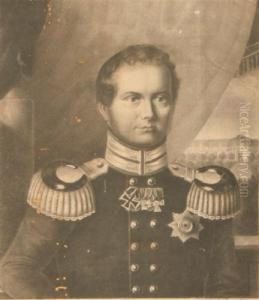Konig Preussen Von Friedrich Wilhelm Iv Paintings
Friedrich Wilhelm IV, born on October 15, 1795, was not an artist in the conventional sense but was the King of Prussia from 1840 until his death. He is known for his patronage of the arts and his interest in architecture, which had a significant impact on Prussian and German cultural life during his reign.
Friedrich Wilhelm was the eldest son of King Friedrich Wilhelm III of Prussia and Queen Louise. He grew up during a tumultuous period marked by the Napoleonic Wars, which influenced his conservative and romantic outlook. As Crown Prince, he received an extensive education and developed an interest in the arts and architecture, which would later characterize his reign.
Upon ascending the throne in 1840, Friedrich Wilhelm IV sought to embody the ideal of a 'romantic monarch'. He envisioned a Prussian state that was rooted in Christian values and the cultural heritage of the Middle Ages, which he tried to reconcile with the modern state. He was a patron of artists and intellectuals and commissioned numerous public works, including the completion of the Cologne Cathedral and the construction of many neo-Gothic buildings in Berlin and Potsdam.
His reign was also marked by political challenges. The revolutionary fervor of 1848 swept through Europe, reaching Prussia with demands for democratic reforms. Friedrich Wilhelm initially conceded to some of these demands but later reneged, preferring a conservative, monarchical approach to governance. He ultimately failed to unify Germany under Prussian leadership, a task that would be completed by his brother and successor, Wilhelm I, with the help of Otto von Bismarck.
Friedrich Wilhelm IV's mental health declined in the latter part of his reign, and he suffered a stroke in 1857 that left him incapacitated. His brother, Wilhelm, served as regent until Friedrich Wilhelm's death on January 2, 1861. Despite not being an artist, Friedrich Wilhelm IV's legacy in the arts endures through the buildings and institutions he supported, which continue to contribute to Germany's rich cultural landscape.
